How to Safely Socialize Your Cat With a Baby or Toddler
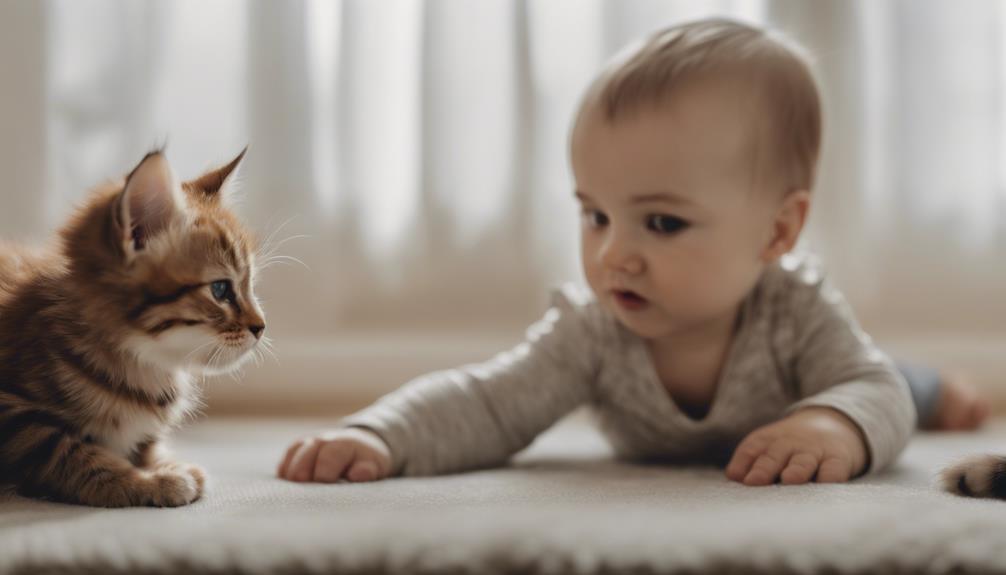
When introducing a cat to new little ones, it's important to watch for signs of stress in your feline friend. Cats may exhibit stress through various behaviors such as hiding, hissing, growling, or even swatting at the children. They may also display physical signs like dilated pupils, flattened ears, or a twitching tail. It's crucial to monitor your cat's body language and behavior closely during this time to ensure a smooth and stress-free introduction process.
Understanding these signs will help you gauge your cat's comfort level and take necessary steps to make the introduction as stress-free as possible. Remember to provide your cat with a safe space to retreat to if they feel overwhelmed and always supervise interactions between your cat and the little ones to prevent any potential conflicts. By being attentive to your cat's behavior and needs, you can help create a positive and harmonious relationship between your feline companion and the new additions to your family.
Setting up Safe Spaces
When introducing your cat to a new baby or toddler, creating safe spaces is essential for their well-being and comfort. Safe havens should be established where your cat can retreat if feeling overwhelmed. These supervised spaces can include cozy cat trees, hiding spots, or elevated perches.
It's crucial to set up secure perimeters around these designated zones to prevent any unwanted interactions between the cat and the child. Baby gates or pet barriers can be useful tools to ensure that your cat has a sanctuary where they feel safe and undisturbed.
Slow and Gentle Introductions
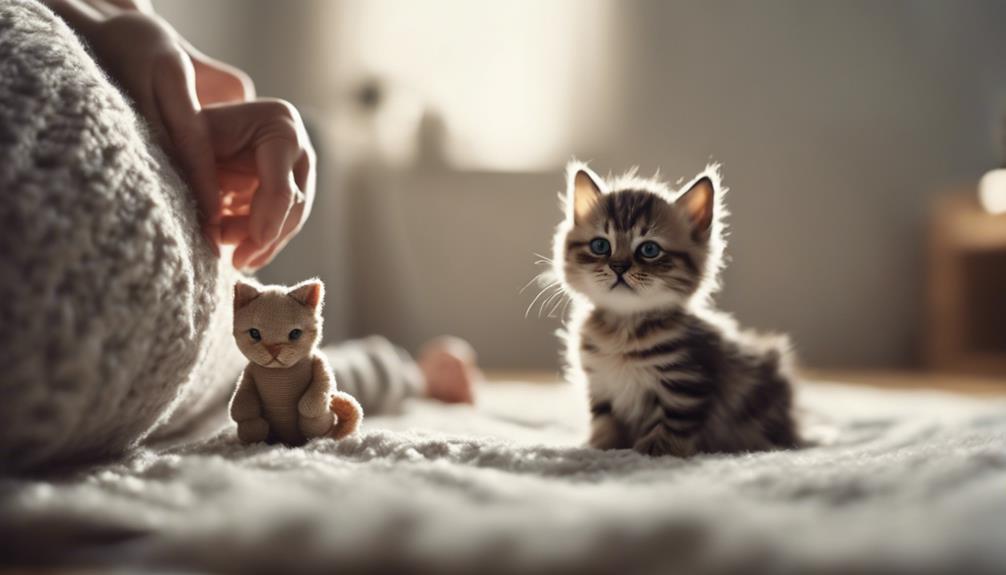
To ensure a harmonious relationship between your cat and a new baby or toddler, it's crucial to introduce them slowly and gently, allowing both parties to acclimate to each other's presence. Here are some practical steps to facilitate a gradual introduction and build trust:
- Separate Spaces: Initially, keep your cat and the new family member in separate areas to allow them to get used to each other's scent and sounds without direct contact. This helps prevent overwhelming either party.
- Supervised Encounters: Once both the cat and the child seem comfortable in their separate spaces, start allowing supervised interactions. This could involve letting the cat observe the baby from a safe distance or allowing them to sniff each other under close supervision.
- Positive Reinforcement: Reward your cat for calm and positive behavior around the baby or toddler. This will help create a positive association and encourage slow integration and gradual bonding between them.
Supervised Interactions
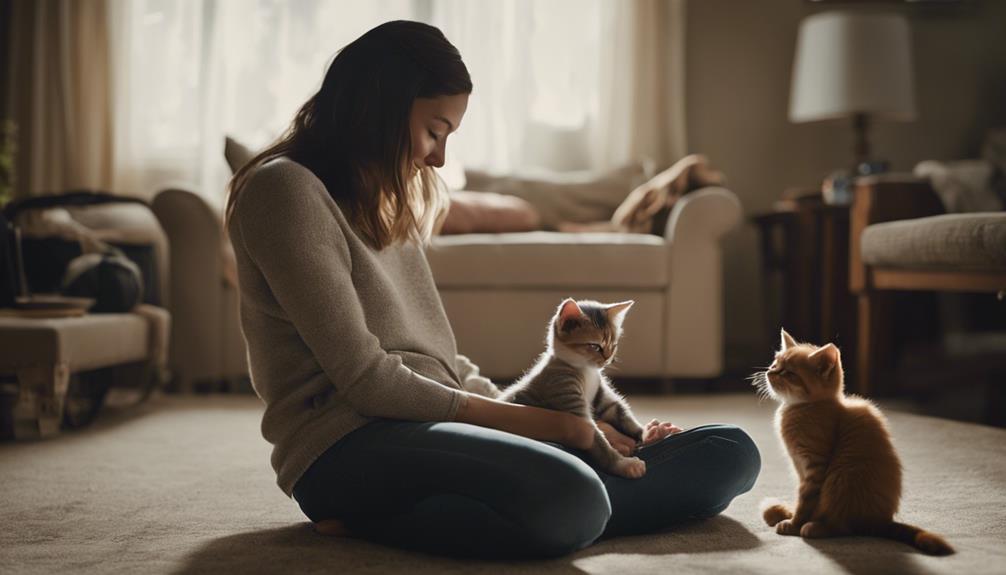
When introducing a cat to a baby or toddler, controlled play sessions are key to ensuring a positive interaction. Using gentle handling techniques can help both the cat and the child feel comfortable and secure.
Positive reinforcement training can also be effective in encouraging desirable behaviors during supervised interactions.
Controlled Play Sessions
During supervised interactions, ensure that play sessions between your cat and the baby or toddler are controlled and guided to promote positive experiences for both. Here are some tips to help you manage these interactions effectively:
- Use Interactive Toys: Provide interactive toys that encourage safe play and keep your cat engaged while preventing any scratching or biting incidents.
- Engage in Enrichment Activities: Incorporate enriching activities that stimulate your cat's mind and body, such as puzzle feeders or climbing structures, to redirect their energy positively during playtime.
- Set Clear Boundaries: Establish boundaries for both the cat and the child, ensuring that interactions are gentle and respectful to create a harmonious environment for everyone involved.
Gentle Handling Techniques
Encouraging gentle handling techniques during supervised interactions is crucial for fostering a positive relationship between your cat and the baby or toddler. Bonding exercises such as gentle petting or interactive play sessions can help build trust and respect between them.
It's important to teach the child to understand the cat's communication cues, like tail flicking or ear flattening, indicating when the cat needs space. Supervising all interactions closely ensures that both the cat and child feel safe and comfortable.
Demonstrating how to stroke the cat softly and avoid sudden movements can prevent any potential stress or fear in the cat. These respectful interactions lay the foundation for a harmonious relationship, promoting a sense of security and companionship for both the cat and the child.
Positive Reinforcement Training
To further enhance the bond between your cat and the baby or toddler, incorporating positive reinforcement training into supervised interactions can be highly effective. Here are some techniques to assist in this process:
- Clicker Training: Use a clicker to associate positive behaviors with a clicking sound, followed by a treat, reinforcing good behavior.
- Desensitization: Gradually expose your cat to the sights, sounds, and smells associated with the baby or toddler in a controlled manner to reduce fear or anxiety.
- Counterconditioning and Shaping Behavior: Reward your cat for calm and positive interactions with the child, gradually shaping their behavior towards more desirable responses.
Positive Reinforcement Techniques
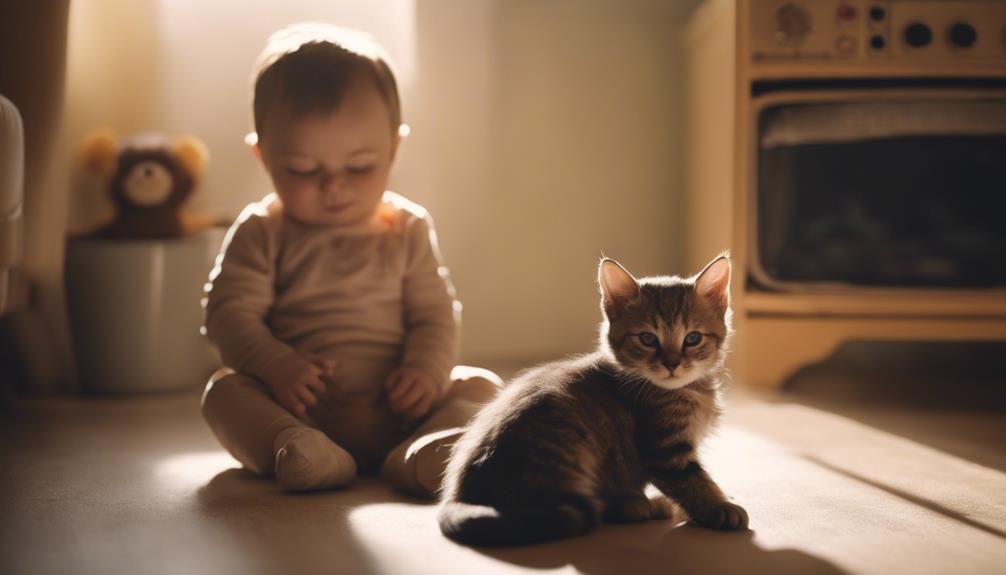
When socializing your cat with a baby or toddler, positive reinforcement techniques can be highly effective.
Rewarding good behavior, strategically using treats, and encouraging gentle interactions are key strategies to help your cat adjust positively.
These techniques can create a harmonious environment for both your feline friend and your little one.
Reward Good Behavior
How can you effectively reinforce positive behavior in your cat when socializing them with a baby or toddler? When rewarding good behavior, keep these tips in mind:
- Immediate Rewards: Offer praise, pets, or a favorite toy right after your cat displays the desired behavior to reinforce it positively.
- Consistency: Be consistent in rewarding good behavior every time it occurs to help your cat understand what's expected of them.
- Clear Communication: Use a consistent verbal cue or clicker to signal when your cat has done something right, helping them associate the action with the reward.
Use Treats Strategically
Using treats strategically can be a powerful tool in positively reinforcing desired behaviors in your cat when socializing them with a baby or toddler. Treat training is an effective method to encourage good behavior in your feline friend. By implementing a reward system, you can help your cat associate positive actions with tasty treats, facilitating behavior modification and obedience training. When socializing your cat with a baby or toddler, it's essential to use treats strategically to create a positive environment for all involved. Remember to choose treats that your cat loves and to offer them promptly after the desired behavior. Consistency is key in reinforcing good conduct through treats, making the socialization process smoother and more enjoyable for everyone.
| Treat Training Tips | ||
|---|---|---|
| Choose high-value treats | Be consistent | Use treats immediately after the desired behavior |
Encourage Gentle Interactions
To foster positive interactions between your cat and a baby or toddler, focus on encouraging gentle behaviors through positive reinforcement techniques. Here are some practical tips to help create a harmonious environment:
- Set Playtime Boundaries:
Teach your child and cat appropriate playtime boundaries to ensure safety for both. Encourage gentle play and provide toys that promote interactive and safe play sessions.
- Facilitate Gentle Introductions:
When introducing your cat to a baby or toddler, do so gradually and in a calm environment. Allow the cat to approach at its own pace and provide positive reinforcement for good behavior.
- Reward Gentle Interactions:
Use treats, praise, or playtime as rewards for gentle interactions between your cat and the child. This positive reinforcement will help strengthen the bond between them.
Establishing Routines and Boundaries
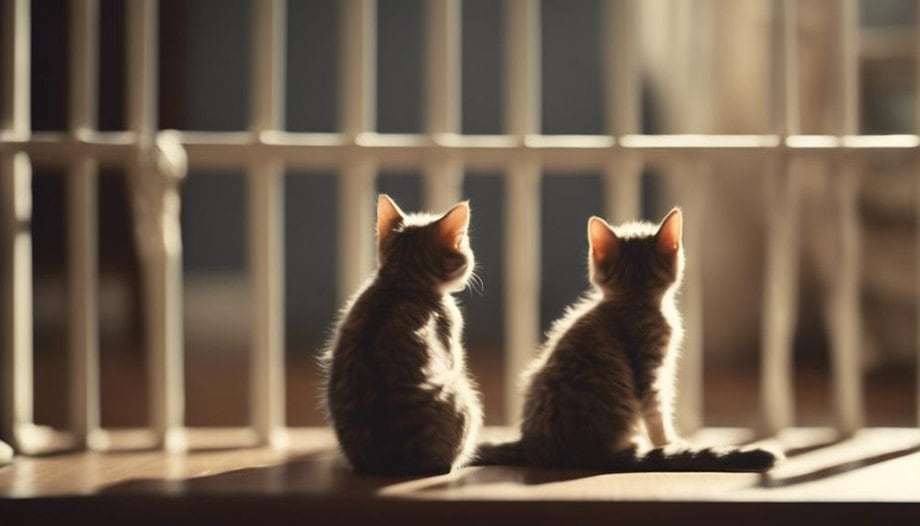
Establishing consistent routines and clear boundaries early on can help your cat feel secure and adjust smoothly to the presence of a baby or toddler in the household. Cats thrive on predictability, so creating a structured environment will aid in reducing stress for both your feline friend and the new addition to your family. Here are some practical tips to assist you in setting up routines and boundaries:
| Establishing Boundaries | Creating Routines |
|---|---|
| Designate cat-free zones where your pet can retreat to when needed | Feed your cat at the same times each day to establish a feeding routine |
| Provide vertical spaces like cat trees or shelves for your cat to escape and observe from above | Set aside daily play sessions to keep your cat mentally stimulated |
| Introduce scratching posts and toys to redirect your cat's energy away from the baby's belongings | Maintain a consistent bedtime routine to help your cat feel secure and relaxed |
| Use positive reinforcement to reward good behavior and discourage unwanted actions | Incorporate interactive toys to engage your cat and prevent boredom |
Monitoring Body Language Cues
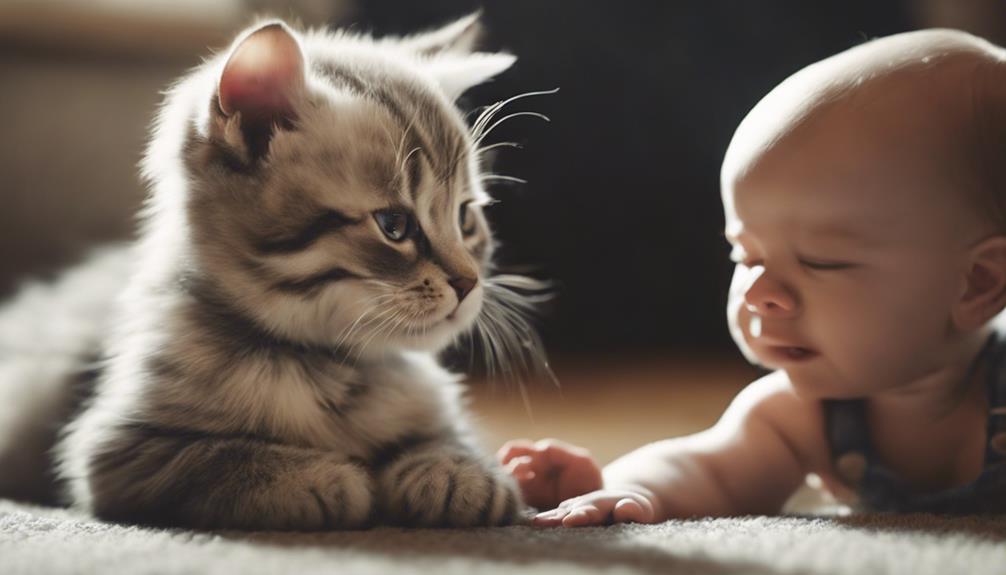
Creating a harmonious environment for both your cat and the new baby or toddler involves closely monitoring your cat's body language cues to ensure everyone feels comfortable and safe in their interactions. Understanding feline behavior is key to interpreting your cat's signals accurately. Here are some essential tips to help you recognize stress signals and maintain a positive environment:
- Tail Position: A cat's tail can indicate their mood. A relaxed and slightly raised tail shows comfort, while a puffed-up or twitching tail may signal agitation or fear.
- Ear Movements: Pay attention to your cat's ears. Forward-facing ears signal curiosity or contentment, while flattened ears indicate stress or discomfort.
- Body Posture: A cat's body posture can reveal a lot about their feelings. Relaxed, open body language suggests comfort, while a tense body, arched back, or raised fur may indicate anxiety or aggression.
Seeking Professional Guidance if Needed
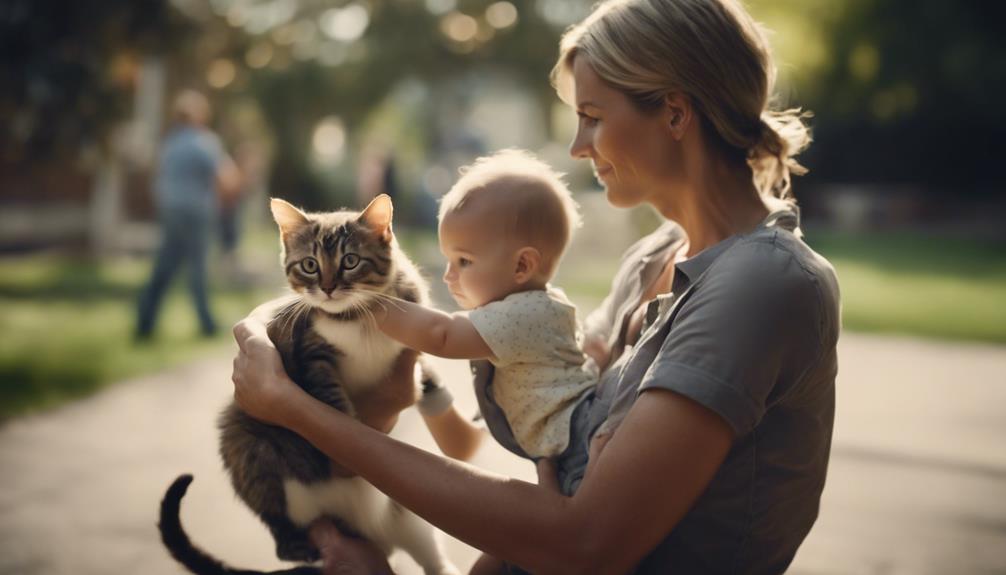
If you notice persistent signs of stress or aggression in your cat despite your efforts to socialize them with your baby or toddler, consider seeking guidance from a professional behaviorist or veterinarian. Professional advice can provide valuable insights into cat behavior and offer tailored solutions for a harmonious environment that ensures child safety. A behaviorist can assess the situation, identify triggers causing stress or aggression in your cat, and recommend behavior modification techniques to address these issues effectively.
It is essential to prioritize the well-being of both your cat and your child. Seeking professional guidance demonstrates your commitment to creating a safe and nurturing space for all family members. Remember that each cat is unique, and what works for one may not work for another. By consulting with experts in cat behavior, you can gain a deeper understanding of your cat's needs and preferences, ultimately fostering a positive relationship between your pet and your child. Don't hesitate to reach out for support when needed; professional advice can make a significant difference in ensuring a peaceful coexistence between your cat and your little one.
Frequently Asked Questions
How Can I Help My Cat Feel More Comfortable Around My Baby or Toddler When They Are Crying or Making Loud Noises?
When babies cry or toddlers make loud noises, cats might get anxious. To help a cat feel comfortable, try using comforting techniques like creating a safe space, positive reinforcement, and interactive play to desensitize them.
Are There Any Specific Toys or Activities I Can Use to Encourage Positive Interactions Between My Cat and Child?
Encourage interactive play between your cat and child through supervised activities like string toys or laser pointers. Use positive reinforcement to foster bonding and socialization. Keep interactions gentle, rewarding good behavior for a harmonious relationship.
What Signs Should I Look for to Determine if My Cat Is Feeling Stressed or Anxious Around My Baby or Toddler?
Recognizing stress signals in cats involves observing their body language for signs like flattened ears or dilated pupils. Creating safe spaces and introducing the cat gradually to the baby or toddler can help alleviate anxiety and foster positive interactions.
How Can I Prevent My Cat From Becoming Territorial or Aggressive Towards My Child?
To prevent a cat from becoming territorial or aggressive towards a child, it's important to establish playtime boundaries and employ appropriate socialization techniques. Consistent positive interactions and supervised introductions can help foster a harmonious relationship.
Are There Any Training Techniques I Can Use to Teach My Cat to Stay Away From Certain Areas or Objects When My Child Is Around?
When teaching a cat to stay away from certain areas or objects around a child, boundary training and behavior modification can be effective. Positive reinforcement and deterrent methods help create a safe environment for both.











